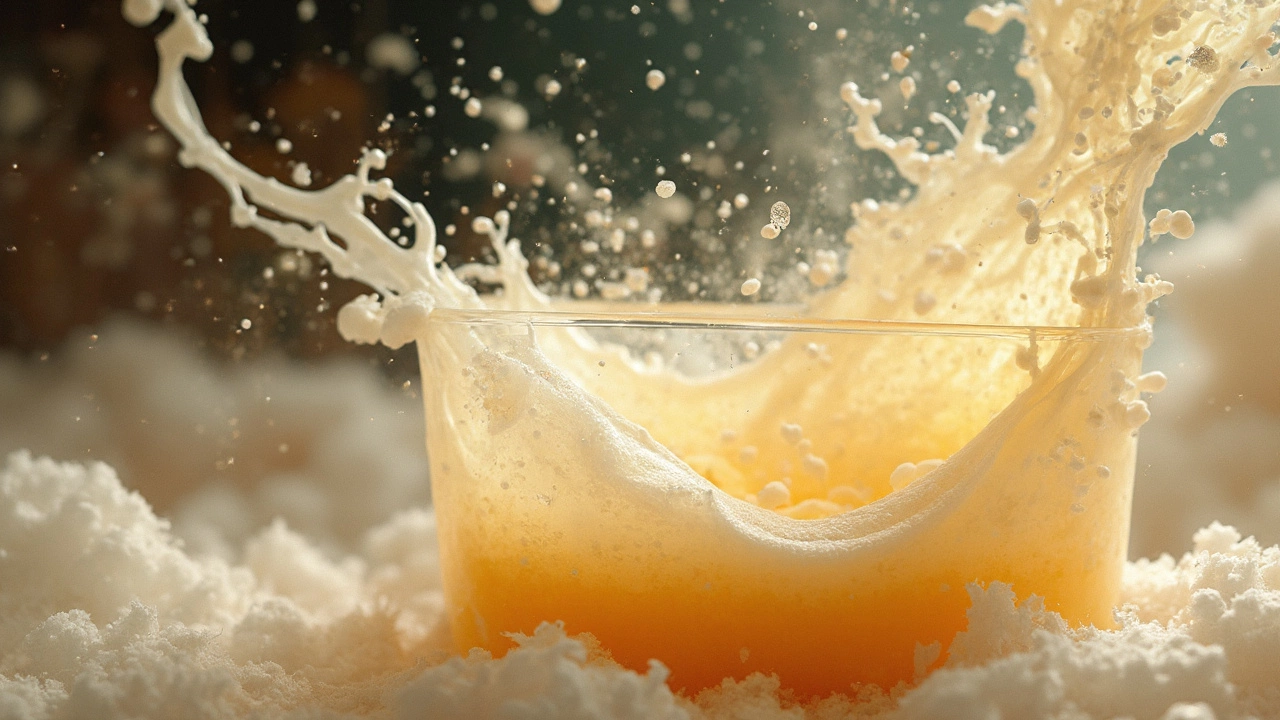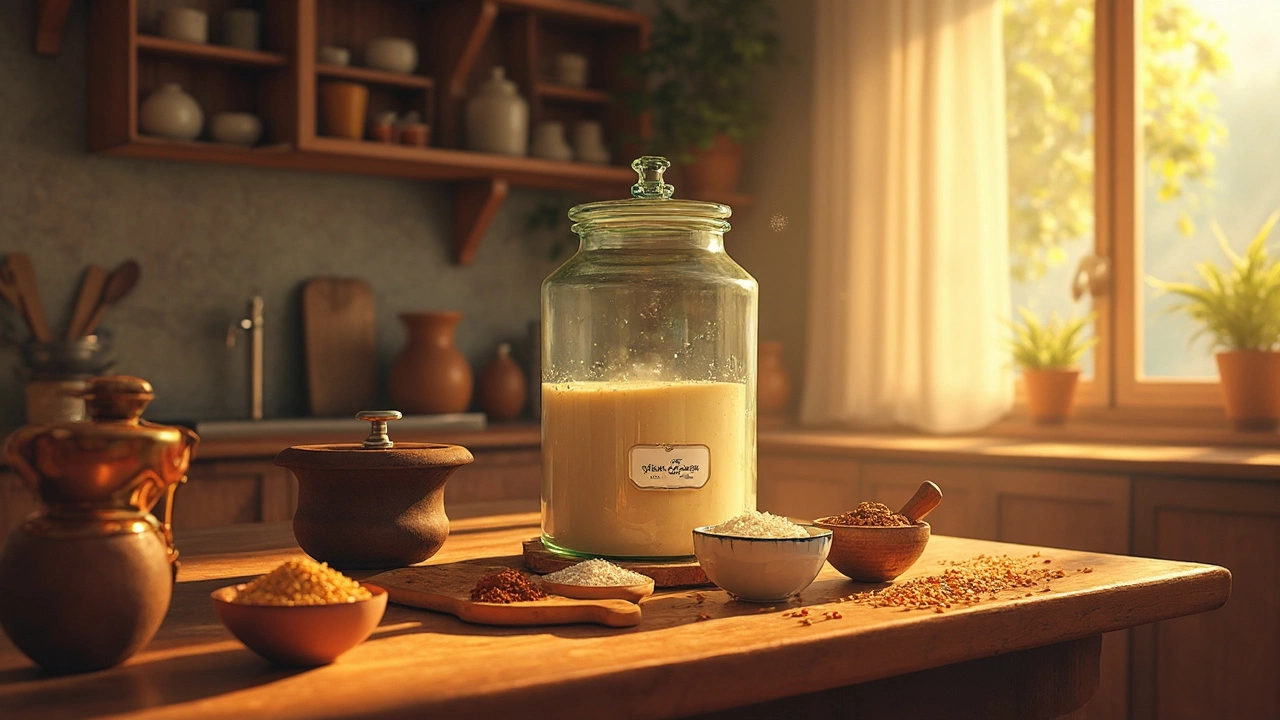So, you've whipped up a fresh batch of dosa batter and wondering how long it'll last? You're not alone! Many of us dive headlong into dosa making without thinking about storage. Generally, dosa batter can last in the fridge for about 3 to 5 days if stored properly. The key is all in the storage.
First things first, use an airtight container. This helps keep unwanted smells and bacteria away. If the batter gets a little sour, that's okay, it just means the fermentation continued. Just make sure it doesn't smell bad or have any discoloration.
Here's a neat trick: Use a large enough container to give the batter some breathing space. Fermentation causes expansion, and the last thing you want is batter oozing out of a tightly packed box!
- Understanding Dosa Batter Basics
- Storing Homemade Dosa Batter
- Tell-tale Signs of Spoilage
- Tips to Make Batter Last Longer
- Creative Uses for Leftover Batter
Understanding Dosa Batter Basics
Making dosa batter is both an art and a science. Traditional dosa batter mainly uses three essential ingredients: rice, urad dal (black gram), and water. Some optional additions include fenugreek seeds for better fermentation and a pinch of salt for taste.
Let's break down the process. First, soak the rice and urad dal separately. Typically, it's 3 parts rice to 1 part urad dal. Soaking time varies but generally lasts about 4 to 6 hours. This helps soften the grains, making it easier to grind.
After soaking, you're in the grinding phase. Use a wet grinder or a high-power blender to achieve a smooth consistency. The texture should be akin to pancake batter—not too runny and not too thick. Balancing the water is key!
Fermentation: The Magical Step
The magic happens during fermentation. Allow the batter to sit in a warm place for 8 to 12 hours. Ideally, it should rise and turn slightly fluffy, indicating that it's well-fermented and ready to use. Temperature plays a huge role here. If you're in a cooler climate, consider placing the container in a warm oven or wrapping it with a towel.
Remember, the end goal is a batter that's naturally fermented, giving dosas their characteristic tangy flavor and crispness. And tip alert: well-fermented batter often delivers the best dosas.
Here's a quick recap of ingredients for a standard batch:
- 3 cups of rice
- 1 cup of urad dal
- Optional: 1 teaspoon of fenugreek seeds
- Water as needed
- Salt to taste after fermentation
Remember, practice makes perfect! Each batch helps you refine your technique, and soon you'll be a dosa-making pro.
Storing Homemade Dosa Batter
Mishandling dosa batter can turn your dreams of crispy dosas into a sticky mess. Let's look at some tips to store your homemade dosa batter the right way and make it last longer.
Choosing the Right Container
To keep your batter fresh, use an airtight container. This helps prevent any funky fridge odors from sneaking in. It’s also smart to pick a relatively large container since fermentation causes the batter to expand a bit.
Before Refrigeration
If you're planning to use the batter the same day, keep it at room temperature to continue fermentation. However, if you’re thinking long term, pop it into the fridge. Make sure the batter is already fermented well enough – it should look bubbly and a little spongy.
Temperature Matters
- Keep your fridge temperature around 4°C (39°F). This ensures a longer lifespan for the batter.
- Avoid the fridge door; it’s warmer there, which may speed up unwanted fermentation.
Maintenance and Stirring
Before making dosas, give the batter a good stir. It’s okay if the batter seems a tad thicker after refrigeration; add a little water and mix.
Signs of Trouble
If it smells off or there’s mold, it's time to let it go. Your dosa batter should have a slightly sour smell, much like yogurt.
| Storage Condition | Expected Shelf Life |
|---|---|
| Room Temperature | 12-24 hours |
| Refrigerated | 3-5 days |
With these simple tips, you can enjoy fresh dosas anytime without worrying if your dosa batter has turned bad.

Tell-tale Signs of Spoilage
So, how do you know if your dosa batter has gone bad? Recognizing spoilage is crucial to ensure you're not ruining your morning with a stomach ache.
Look and Smell
Your senses are your best friends here. Start by giving the batter a good look. If you see any discoloration—like a patch of unusual green or black—that's a red flag. Toss it out!
Next, take a sniff. A homemade dosa batter will have a natural tangy smell due to fermentation, but if it smells downright funky or unpleasant, err on the side of caution and don't use it.
Texture Check
Sometimes, spoiled batter tends to clump up or develop a weird watery split. Stir a little to check consistency. If it feels off, it's best not to risk it.
Watch Out for Mold
Mold doesn't always come with a green or black color. Sometimes, it can be white and fluffy, blending in with the batter. Inspect closely before use!
Additional Tips
- Check the date: Always mark the container with the date you made the batter. It's easy to forget as days blur by!
- Feel it out: Trust your gut. If anything seems amiss, better safe than sorry.
Recognizing these signs of spoilage can save you some serious trouble. Remember, when in doubt, throw it out!
Tips to Make Batter Last Longer
Keeping your dosa batter fresh is a game-changer. Ever had to deal with sour or spoiled batter? Annoying, right? Here are some practical tips to make sure it stays good for longer, and you get the best out of it.
Keep It Cool, Keep It Fresh
Alright, the first rule of thumb: refrigerate the homemade dosa batter as soon as you're done using it. The chilling process slows down fermentation which is great for extending its life.
Use a Clean Spoon
Avoid using a wet or contaminated spoon to scoop out the batter. It might seem minor, but introducing any unwanted bacteria can speed up spoilage.
Airtight Containers Are Key
Store the batter in airtight containers. This not only keeps the odors of the fridge from seeping in but also prevents any yeast or bacteria from getting in and spoiling your batter.
Freezing for Future Use
Got too much batter? Freeze it! Yes, you heard that right. You can freeze the batter in portions, and they can last up to a month. Just make sure to thaw it naturally before using it.
Table of Batter Storage Tips
If you're a numbers person, here's a handy table:
| Storage Method | Timeframe |
|---|---|
| Refrigeration | 3-5 days |
| Freezing | Up to 1 month |
Don't Crowd the Container
When storing the batter, don't fill the container to the brim. Leave some room for expansion during repeated fermentation cycles, it prevents overflow and spoilage.
Follow these tips, and your dosa batter will last longer, letting you enjoy delightful dosas whenever you're in the mood!

Creative Uses for Leftover Batter
Got some leftover dosa batter in your fridge and don't want to waste it? No worries, there are plenty of creative ways to use it up. With a little imagination, you can whip up a variety of delicious dishes!
Uttapam Delight
If you've never tried making uttapam, you're in for a treat. Think of it as a thick, pancake-like dosa that uses the same dosa batter as the base. Add chopped veggies like onions, tomatoes, and capsicum right on top of the batter while cooking. Don't forget a sprinkle of chili and coriander for an extra kick!
Savory Pancakes
Turn that homemade dosa batter into a tasty breakfast or snack. Mix the batter with some grated carrots or spinach for an easy savory pancake. Serve with a dollop of yogurt or your favorite chutney on the side.
Batter Bonda
If you're up for something a bit more crispy, try making bonda. Combine the batter with mash potatoes, spices, and a bit of salt. Shape them into small balls and fry until golden. They're super snackable and perfect for tea time!
Indian Omelette
Give your regular omelette a twist by mixing in some dosa batter. Just toss in your favorite omelette ingredients like tomatoes, onions, and chilies into the batter. Cook it in a pan, and voilà – an Indian twist on a classic dish!
Sweet Dosa
For those with a sweet tooth, you can add some jaggery and coconut to the batter. Cook it similar to a dosa and you'll have a sweet treat that's delightful for a dessert or a special breakfast.
So, next time you're eyeing that container of batter in your fridge, remember these creative ideas. Waste not and enjoy the versatility of your homemade dosa batter!
